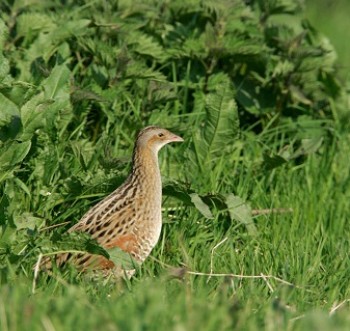Supporting guidance for Corncrake Grazing Management
Date published: 30 March, 2015

Corncrakes are a ground-nesting bird, related to moorhens and coots, that live on dry land. They are a summer visitor to Scotland, over-wintering in Africa.
To survive and breed successfully, corncrakes need:
- safe nesting habitat in crops and hay / silage fields
- tall vegetation (ideally over 20 centimetres in height) that provides cover during breeding and chick rearing
The Corncrake Grazing Management option provides cover throughout the breeding season.
Cover in spring, early cover, is usually provided by tall herbs with an early growing season such as iris, nettles and cow parsley.
Late cover is provided by long grass and herbs.
What needs to be done
This option requires the exclusion of livestock from fields from 1 March to 15 August. This allows herbs and grasses to grow to a suitable height without being grazed back by livestock.

Ideal corncrake habitat, with lots of cover provided by iris and reeds – Credit: Andy Hay – © RSPB images
Ideally, some vegetation in the field should be 20 centimetres in height by the first week in May. Adding nutrients to parts of the plot where tall herbs occur such as rotten silage bales, farmyard manure or seaweed can help to achieve this. Nutrients should be added to the plot before 15 March.
At the end of the season, this growth needs to be removed by grazing or cutting to prevent the sward from becoming rank. Do this through grazing where possible. If grazing alone cannot remove annual growth, you can cut the vegetation between 15 August and 1 March of the following year.
Which fields to choose
This option is designed to provide cover throughout the breeding season. Therefore, fields selected should contain herbs with an early growing season as well as grass.
Ideally, tall herbs should occupy at least 30 per cent of the area and be distributed across the field, and not exclusively confined to field margins or small parts of the field. These may include iris, nettles, meadowsweet, cow parsley, hogweed, reed sweetgrass, common reed, butterbur and managed rush.
This is not an exhaustive list of suitable plants, so contact your local advisor if you have a query.
Avoid swards matted with dead plant material from previous seasons’ growth.
How to increase the success of this option
To be most effective, the area of ground managed under this option should be at least 0.5 hectares, with at least 30 per cent covered by tall herbs. This option will be most beneficial for corncrake when combined with options that provide cover and protect nest sites. Select fields adjacent to plots that can be managed under one of the following options:
Further information
For further information on corncrake conservation you can contact the RSPB advisory services on 0131 317 4100 or your local Scottish Natural Heritage office.
